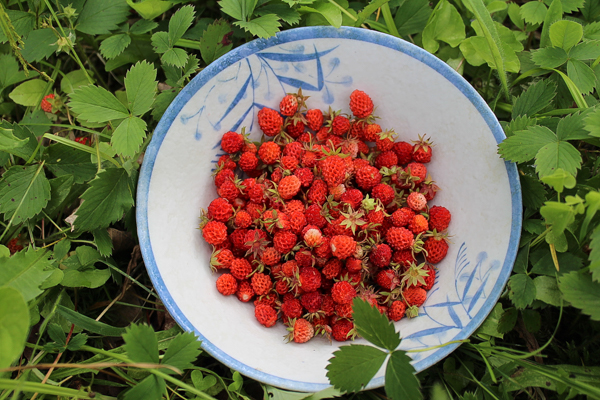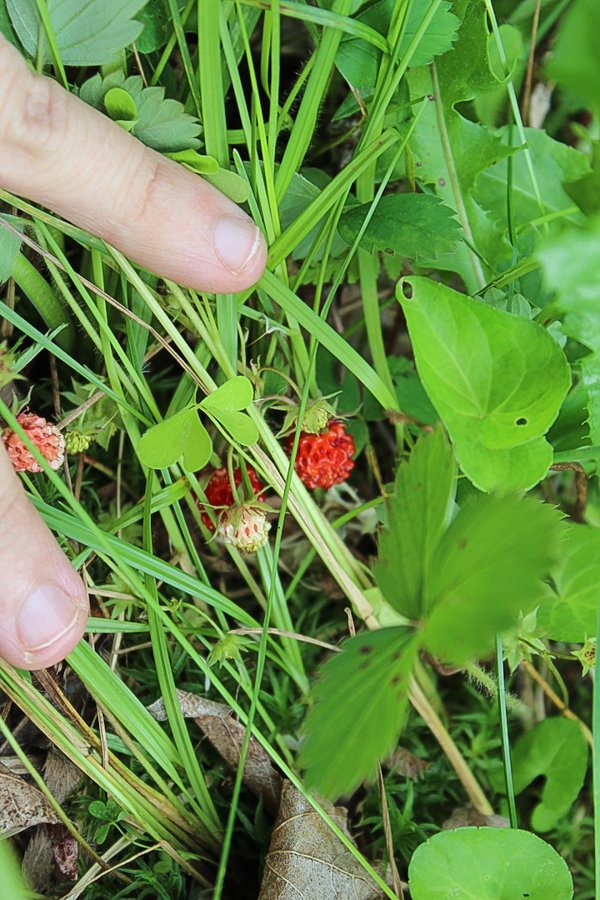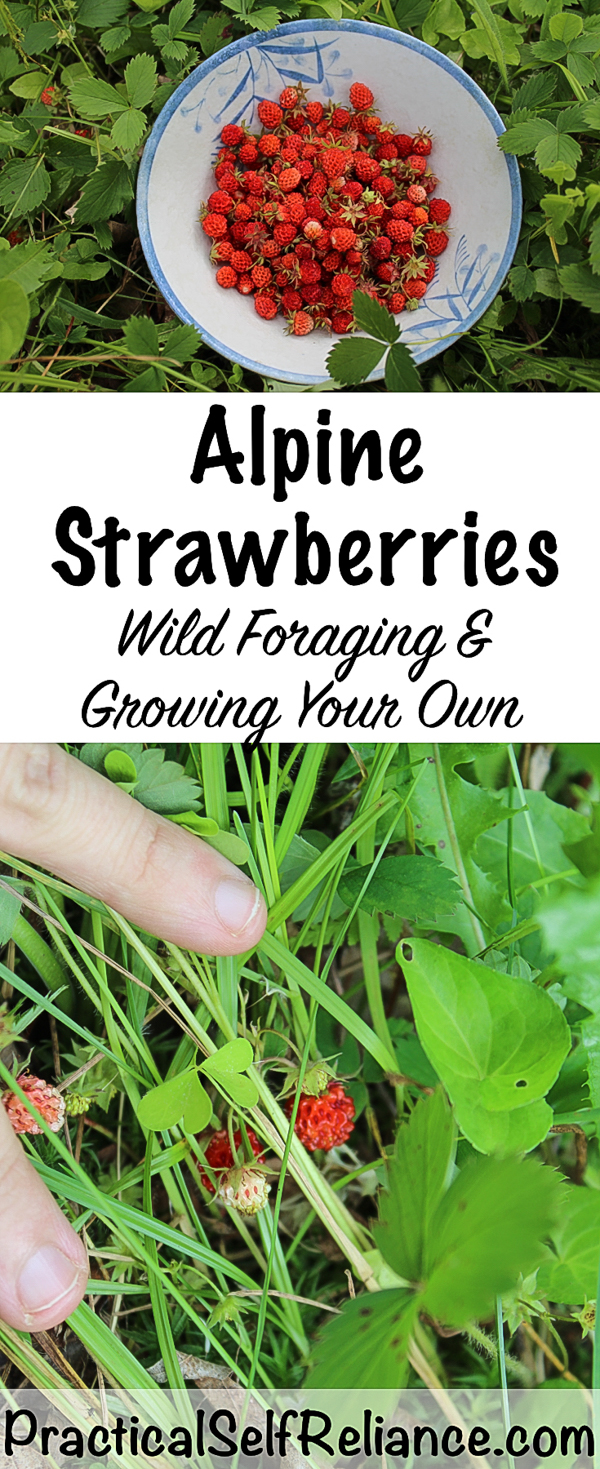Affiliate disclosure: This post may contain affiliate links. Please see our Privacy Policy.
Wild alpine strawberries are a perfect demonstration of selective plant breeding. While it’s hard to see how a wild grass turned into a modern corn plant, strawberries are different. Looking at an alpine strawberry, with a little imagination you can envision the gigantic strawberries of today.
Modern supermarket strawberries are more or less a testament to progress. So why would you want to bother with finding wild strawberries?
The truth is until you’ve tasted a wild strawberry, you’ve never really experienced all that a strawberry can be. What these little beauties lack in size, they make up for in flavor.

Table of Contents
Our ancestors propagated wild strawberries, selecting for durability, size, and shelf life. Practically speaking, the flavor had to take a back seat to yield.
Durability is key, as a modern strawberry can be kept and shipped across the country to feed urban populations. Wild alpine strawberries are almost always bruised during picking and rarely last more than 24 hours.
The only way to truly enjoy a wild alpine strawberry is to either forage it in the wild or cultivate it in your garden.
Growing Alpine Strawberry Plants
If you find a particularly tasty alpine strawberry, that ideally also has larger than average berries, that’s the perfect plant to transplant back home. Alpine Strawberry Plants have very shallow and durable root systems. They naturally propagate by runners, and a single plant can easily self-propagate into many plants in the course of a year.
If you don’t have access to wildlands to gather alpine strawberry plants, they can also be started from seed at home. Alpine strawberry seeds are easy to grow, and once you get your own patch started they’ll self-propagate forever.
That’s the nice thing about a “wild” crop. It knows how to take care of itself. Ours grow right up on the lawn along woods edges and shady places. Anywhere they can get a foothold, they thrive.

Though all of the wild strawberry plants I’ve found on our land produce red berries, there are heirloom varieties that produce very different fruit. Seeds saved for generations produce unique plants. One such variety is called Heirloom Pineapple and produces 1 inch long yellow fruits that taste like a cross between a pineapple and a rose blossom.
Another variety called “White Soul” produces snow white fruit. This one, in particular, might get confusing, as you’ll never quite know when to harvest. If you’re growing white strawberry varieties they’ll make for a dramatic presentation on your table, but make sure you keep them in containers without regular red plants present.
Alpine strawberries are good choices for rocky outcroppings, assuming you have enough rain in your location to support them. Some of our best crops come right out of rock walls and rocky embankments where they’re able to outcompete the grass.
They also prefer moist soils, making them a perfect candidate for slightly soggy portions of lawn that are otherwise short grass and moss.

Foraging Alpine Strawberries
If you are near wild areas, or at least a decent walking path near the woods, alpine strawberries should be easy to find. They prefer woods’ edges, where they’re able to get partial sunlight.
Rocky areas or locations with shallow soils are also great places to find wild strawberries. They have very shallow root systems, so they can thrive where deep-rooted perennial grasses cannot.
Wild strawberries (Fragaria vesca) are known by the names Woodland Strawberry and Alpine Strawberry. That gives you a few hints on where to find them. Higher elevations and wooded locations are a good start. While they can’t grow in dense woods, clearings, edges, tree falls and anywhere with a bit of sun streaming in can be just enough.





Wow, so much interesting info on these wild strawberries that I’ve not found in the US so far until now! Fantastic!! Thank you all, now I know where to get them, what to look for and how to grow. Thanks so so much!!
You’re welcome!
Thank you I look forward to all information from you.I love the idea of planting once and harvesting forever.
I’m gonna jump to her defense here and say that what she has grown is, indeed, Fragria Vesca, more specifically, Fragaria Vesca Americana. Its a sibspecies that is EXTREMELY common amongst most of the mid-to-northern latitude U.S., including Canada and Alaska. It, similar to Fragaria Virg., also has a very similar shape and size, but tends to be much more prolific, slightly smaller, and has a longer growing season.
Also, ALL strawberries are Haploid, meaning they have 7 chromosomes. Vesca is indeed diploid, meaning only that it has 2 sets of these. F. Virg. Is indeed octoploid, meaning it has 8 sets. Its generally assumed that most strawberries descended from diploid ancestors, considering that the genome of Virg. only reads out as two similar sets overall, with each chromosome set looking something like this: AAA’A’BBB’B’. Chilo. And Virg. Are both octoploid, but their chromosome sets are virtually identical, which is what made them so attractive to hybridize into the modern garden variety.
However considering her location, the appearance of the aggregate fruit, and the shape and size of the leaves, and the length of the season, I would say for certain that this is F. Vesca Americania.
Hey just to let you know that the Strawberry’s pictured are in-fact not “alpine strawberry” (fragaria vesca) but “Scarlet Strawberries” fragaria virginiana. They are different species, although in the same genus, with alpine strawberries being endemic to Europe and central Asia and Scarlet strawberries being native to the North American Continent. The scarlet strawberry which is the one you have is one of two ancestors of the modern cultivated strawberry (Fragaria × ananassa) with the other parent being fragaria chiloensis. Both these species differ from alpine strawberries as they are octoploid meaning they contain eight sets of chromosomes each whilst alpine strawberry is diploid containing only two and therefor not compatible. Sorry if this was a lot of info just thought you might find it interesting, Best Alex.
Thanks Alex for pointing this out, I was thinking the same while looking at the pictures. Yes, the Fragaria vesca varieties are very common in Europe (woodland strawberries) and were an essential part of my childhood. Now I am growing several varieties and species, including the American wild Fragaria virginiana kind, hoping to taste it one day (no flowers yet, only foliage)… I have read that the flavor is excuisite, just as it is with the Frag vesca.
I grow White Soul alpine strawberries, they are actually a little bit yellow when ripe and they fall right off the plant when they’re ripe. If you need to tug at all they aren’t ready yet 🙂 You’re very luck to have so many wild ones!